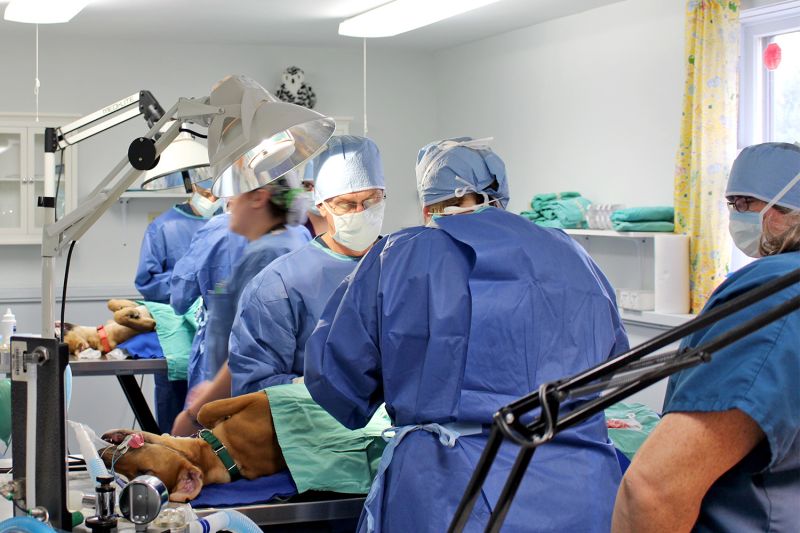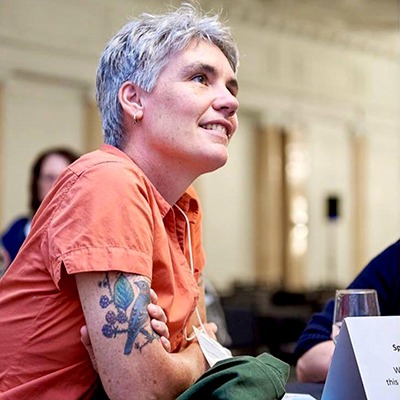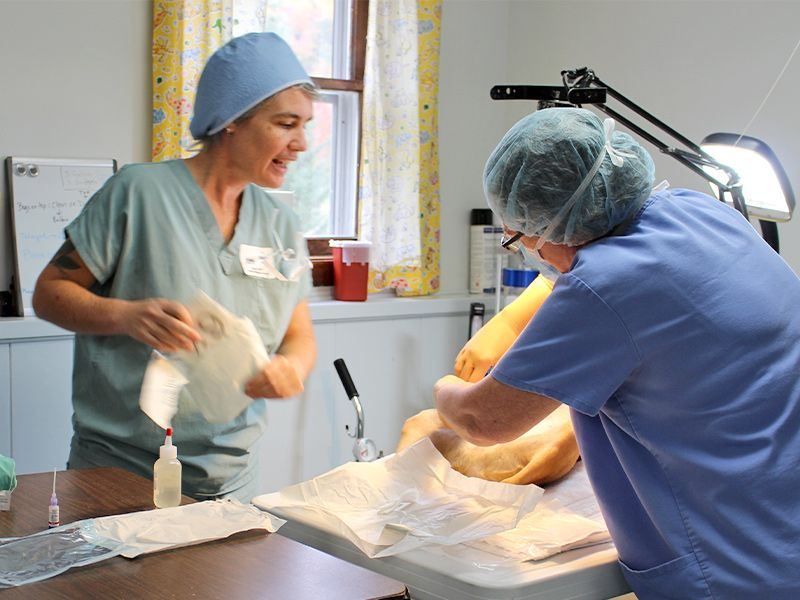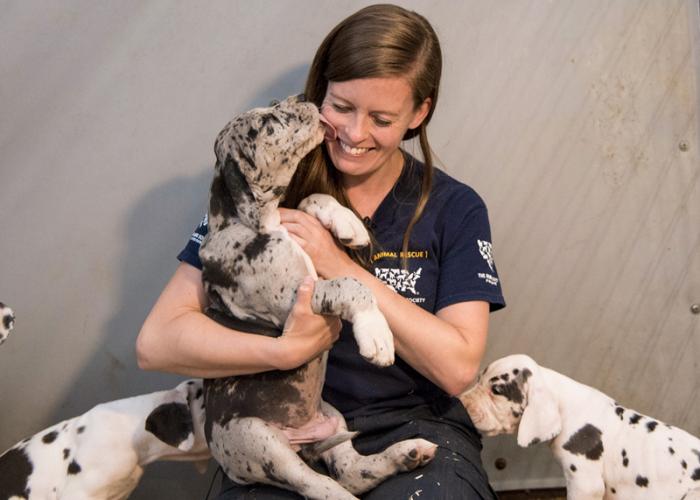Ask the experts: High-volume spay/neuter training
By training a few vets at a time in HQHVSN techniques, Vermont nonprofits increase spay/neuter capacity in their state

Not long after graduating vet school, when Dr. Sara White wanted to learn high-quality, high-volume spay/neuter techniques, she joined a Yahoo listserv for shelter veterinarians. This was more than 20 years ago, “before the internet had pictures,” she says, so group members had to painstakingly describe their techniques using just words.
Applying what she learned from the group, and with some mentoring from a vet friend, White learned “piece by piece.” In 2006, she launched Spay ASAP Inc., a nonprofit that operates MASH-style spay/neuter clinics in collaboration with local humane organizations throughout Vermont and New Hampshire.

Today, veterinarians who want to learn HQHVSN skills have a lot more resources, including programs such as the ASPCA Spay/Neuter Alliance, Rural Area Veterinary Services, White's YouTube videos and books. The demand for veterinarians who specialize in spay/neuter has also grown.
More shelters are looking to hire their own vets, not just to care for their own animals, but also to provide low-cost spay/neuter services to their communities, says Pamela Krausz, founder and executive director of VT-CAN (Vermont Companion Animal Neutering), a nonprofit spay/neuter clinic in Middlesex. But finding vets who are trained in HQHVSN has become increasingly difficult.
Last year, while brainstorming strategies to increase spay/neuter numbers in their state, White and Krausz decided to organize a small “wet lab” (in veterinary lingo, a wet lab is training that involves actual patients). In one busy day last fall, White and VT-CAN staff veterinarian Dr. Laura Ladds provided six hours of intensive training in HQHVSN to Vermont shelter veterinarians and technicians.
White and Krausz, for their part, learned that the wet lab provided a host of benefits for a total cost of just $4,800, which was provided by the Vermont Humane Federation.
“For that, we got three vets and two vet techs trained and 60 animals from five shelters spayed or neutered,” Krausz says. “The training was free for the learner vets and their techs, and all our regular staff were paid their regular pay plus an extra stipend.”
In this edited interview with HumanePro, White and Krausz explain how training a few vets and techs at a time can have a big impact on local spay/neuter capacity.

How did the idea for the mini wet lab come about?
White: Three shelters in the state had vets who were essentially new to HQHVSN and shelter medicine. They were asking if they could send their vets to our regular clinics, but it’s hard to teach and work at the same time. I don’t have an extra surgery table, so they can come talk with me and watch, but I can’t offer them more than a cat neuter or two.
To get as much spay/neuter happening in Vermont as we could, we decided to have a wet lab for those vets and any techs they were working with and have me and my tech and Pamela’s team devoted to teaching.
Krausz: Some of the shelters had the money to send people to the ASPCA Spay/Neuter Alliance training but couldn’t because of COVID and limited spots. We thought this was one way we could do a little something, get some of the techniques out there.
What change did you see in the trainee vets’ surgery skills?
White: They were already in a pretty good place as private practitioners but just not confident or ready to be more high-volume practitioners. One vet came from dairy practice and wasn’t doing dog surgeries [at the shelter].
They were all excited to try new surgery techniques with supervision. It can be scary to try that new knot on your own, and we could watch them do it multiple times. By the end of the day, they were able to do surgeries more smoothly, more confidently. You could see the difference.
“It’s harder, especially in smaller rural shelters, to even have a grasp on what high-volume efficient surgery is like. This was a way of introducing the smaller, starting out clinics to ways they can create a more efficient space.”
—Sara White, DVM
What else did the shelter staff learn?
Krausz: We showed them small things that increase efficiency or save money, like putting tattoo ink in contact lens cases and how to make your own mask holders. These are all things we learned from other clinics.
White: It’s harder, especially in smaller rural shelters, to even have a grasp on what high-volume efficient surgery is like. This was a way of introducing the smaller, starting out clinics to ways they can create a more efficient space.
Aside from an experienced HQHVSN veterinarian who likes to teach, what else do you need to host a training like this?
Krausz: You don’t need a large space or a lot of money. Our clinic is tiny. There are a lot of ways to maximize the space by thinking vertically and using mobile shelving to hold carriers. We also added another table in our surgery suite. Scheduling animals in shifts also increases capacity.
White: Because we’re two different clinics, we had enough additional equipment, like anesthesia machines. I think a wet lab would be possible even if you didn’t have the extra equipment, but if you can work with other programs or shelters to borrow equipment for a day, that’s really helpful. With our three learner vets and three surgery tables, we were able to get people doing surgery nonstop, which really helps with learning the skills.
I’d coordinated quite a few large wet labs before in conjunction with major vet conferences with instructors and students from all over the country. Getting temporary licensing for all the out-of-state vets and instructors is a lot of work, and so is coordinating the RACE continuing education credits. This small wet lab ended up being so much simpler because I wasn’t having to go through licensing agencies and CE accreditation. Even without CE credits, it was worth it for the vets and techs.

How can organizations apply this model to increase spay/neuter capacity in their communities?
Krausz: It depends on your goals, but you could also share the techniques with full-service private practice vets. In some places, they’re scheduling surgeries so far out that even people who can afford private practice rates can’t get their pets in on time to prevent an accidental litter. That’s a problem.
White: This can also be a way to introduce private practice vets to HQHVSN, to show them that we’re a legitimate part of this profession. We’re not just adequate; we’re experts, and we have skills we can teach you.
How does running a wet lab differ from your normal spay/neuter clinics?
Krausz: You want to make sure you have a mix of animals, including puppies, kittens, and overweight female dogs and cats. Make sure you plan and organize well and have enough volunteers and staff. I’d rather have people standing around than not have enough help, because once it starts, it’s hectic.
Think about the flow and have a little talk in the morning to let the learner vets and techs know how it’s going to go. Keep an eye on the schedule. If surgeries are going slower than expected, the teaching vets will have to do surgeries at the end of the day or during lunch.
White: Most of the supplies you need for the wet lab are the same ones you need for a regular surgery day, but you need to have different size gloves to accommodate everyone, and your surgery tables need to be set up so tall surgeons and short surgeons can work comfortably.
Including some more challenging surgeries like pregnant spays or cryptorchid neuters can give surgeons a chance to learn additional techniques.
“If you can be confident in a surgery, if your cat spay is eight minutes rather than 15, you’re going to feel better at the end of the day. You either get a lot more cats done or have a shorter day, so there’s less burnout.”
—Sara White, DVM
What feedback did you get from the trainees?
White: They left with confidence, which is a big thing. If you can be confident in a surgery, if your cat spay is eight minutes rather than 15, you’re going to feel better at the end of the day. You either get a lot more cats done or have a shorter day, so there’s less burnout.







